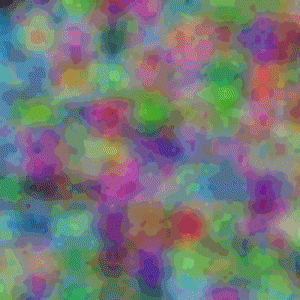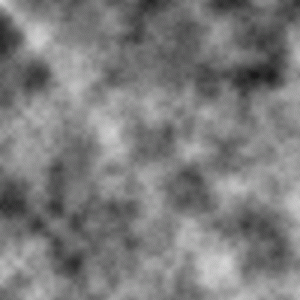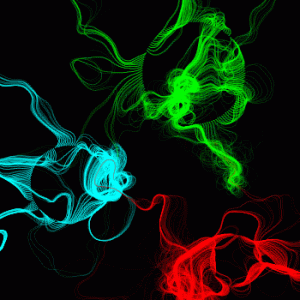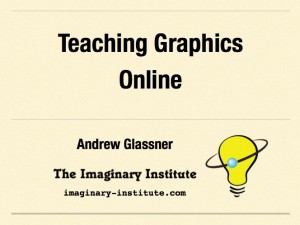 Some people have asked for an implementation of the noise blending technique in my previous post. Here’s the Processing code for the core idea. Keep in mind that this is just about making a smoothly changing noise field; what you do with that noise is up to you! Continue reading
Some people have asked for an implementation of the noise blending technique in my previous post. Here’s the Processing code for the core idea. Keep in mind that this is just about making a smoothly changing noise field; what you do with that noise is up to you! Continue reading
Monthly Archives: August 2014
Noise Blending for More Exciting Animation
 We often use Perlin-esque noise functions to create complex graphics (the noise function built into Processing is just such as function). We can save a value of noise at every pixel in our graphics window, creating a field of noise. The value of these fields is that, unlike white noise, these fields contain visible structure at multiple scales, and that structure usually creates interesting graphics. But when we animate these images they often seem to be missing a certain oomph. This note discusses one way to get that excitement back in there! Continue reading
We often use Perlin-esque noise functions to create complex graphics (the noise function built into Processing is just such as function). We can save a value of noise at every pixel in our graphics window, creating a field of noise. The value of these fields is that, unlike white noise, these fields contain visible structure at multiple scales, and that structure usually creates interesting graphics. But when we animate these images they often seem to be missing a certain oomph. This note discusses one way to get that excitement back in there! Continue reading
Work In Progress
 I’ve been making little doodles with my new Processing library. The goal is to make it better by finding and fixing bugs, and making it easier to use overall. Here’s something I made this morning roughly based on an earlier sketch. It uses my 2D array to store multiple noise images, my animation controller to sequence the noise fields, and my camera to make motion-blurred final frames. Click the picture to see the animation!
I’ve been making little doodles with my new Processing library. The goal is to make it better by finding and fixing bugs, and making it easier to use overall. Here’s something I made this morning roughly based on an earlier sketch. It uses my 2D array to store multiple noise images, my animation controller to sequence the noise fields, and my camera to make motion-blurred final frames. Click the picture to see the animation!
Making A Processing Library
 While programming in Processing, I’ve developed about a dozen useful tools for everyday work. I’ve packaged these up in a library which I call AU, for “Andrew’s Utilities.” I’ll be sharing it as soon as I finish the documentation. Although the official Processing wiki has a nice walkthrough for how to make a library, there are a few things that I spent considerable time figuring out. Here’s what I learned, to save you the effort.
While programming in Processing, I’ve developed about a dozen useful tools for everyday work. I’ve packaged these up in a library which I call AU, for “Andrew’s Utilities.” I’ll be sharing it as soon as I finish the documentation. Although the official Processing wiki has a nice walkthrough for how to make a library, there are a few things that I spent considerable time figuring out. Here’s what I learned, to save you the effort.
Continue reading
SIGGRAPH 2014 Slides
 Here are the slides for a talk I gave at SIGGRAPH 2014 in Vancouver, B.C., The talk was about my experiences putting together the Imaginary Institute class, “2D Animation and Interaction.” You can download the slides here.
Here are the slides for a talk I gave at SIGGRAPH 2014 in Vancouver, B.C., The talk was about my experiences putting together the Imaginary Institute class, “2D Animation and Interaction.” You can download the slides here.
